Do-it-yourself long-burning boiler
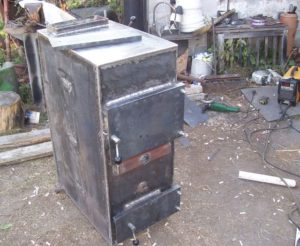 Long-burning boilers have become in demand with the growth of private housing construction. Purchasing an industrial heating device costs a significant amount. Do-it-yourself boilers can reduce costs. A competent drawing, the ability to understand it correctly, and careful adherence to the instructions will help any potential user accomplish this task.
Long-burning boilers have become in demand with the growth of private housing construction. Purchasing an industrial heating device costs a significant amount. Do-it-yourself boilers can reduce costs. A competent drawing, the ability to understand it correctly, and careful adherence to the instructions will help any potential user accomplish this task.
The content of the article
How to make a long burning boiler
This group includes heat generators with a firebox, the dimensions of which are increased compared to ordinary models. A larger amount of solid fuel ensures a longer combustion time and a larger volume of heat generated. Manufacturers offer ready-made boilers with the following indicators for the duration of fuel combustion until the next fuel filling:
- firewood and wood industry waste – up to 12 hours;
- coal - up to 24 hours.
Other alternative fuels are used for heating:
- briquetted peat;
- bagged pressed wood waste – sawdust, shavings, bark;
- birch charcoal;
- packaged landfill waste products.
Reference! The cheapest fuel is considered to be ordinary sawdust, provided that its moisture content does not exceed 20%.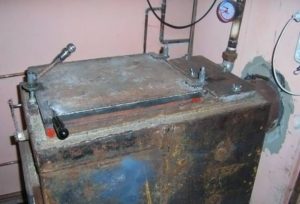
You can make a boiler with the same operating parameters yourself. When starting work, you need to decide on the characteristics of the future unit. The following are considered significant parameters for boilers:
- power;
- burning duration;
- coefficient of performance (efficiency);
- maximum permissible operating pressure;
- nominal pressure in the system;
- total and useful volume of the firebox;
- firebox depth;
- maximum log length;
- volume of the tank;
- boiler weight.
These parameters will be individual for each type of boiler.
Reference! The heating area depends on the boiler power. A boiler with insufficient power will not be able to heat the entire building completely.
The operation of this type of heat generator is based on the physical property of the heat generated during fuel combustion being transferred to a heat exchanger. The method of heat transfer depends on the design of the heat exchanger.
The duration of combustion is affected by:
- fuel tank volume;
- the degree of isolation of the chimney draft from air entering it (solid fuel in the firebox should smolder slowly and not flare up).
The manufacture of a boiler begins with the choice of its design and the problem it must solve:
- For small premises (garage, country house, outbuilding), a simple boiler without a water jacket is suitable, operating on the principle of an ordinary furnace, when heat is transferred through the walls of the structure by convection of thermal air.
- To heat a house, a more complex and reliable design is required. In this case, it must be taken into account that the heat generator will operate continuously over a long period of time.
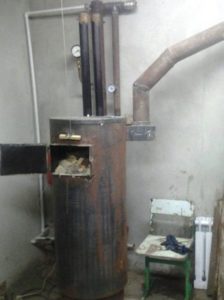
Depending on the location of the firebox, boilers are:
- with top combustion;
- with lower combustion (less productive in terms of loading volume and burning time until the next filling).
According to the body shape:
- cylinder;
- rectangle.
Required materials and tools
The first stage of work is preparation materials and components. To work you will need:
- low carbon steel 3-4 mm thick;
Important! Steel grades St 35 and higher are unsuitable for conventional welding due to their high carbon content.
- pipe DN50, 150 – for models with a tubular heat exchanger;
- rectangular pipe 60x40 mm - for making an air channel;
- equal angle corner - for grates;
- steel strip 20x3 mm;
- basalt insulation 2 cm thick (density not less than 100 kg/m³);
- metal sheet (can be coated with polymers) 4-5 mm thick - for making doors;
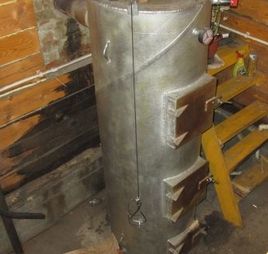
Attention! You can buy ready-made cast iron doors, matched to the size of the firebox.
- asbestos cardboard - for thermal insulation of doors;
- asbestos cord;
- electrodes;
- control Panel;
- fan;
- temperature sensor;
- door handles.
Reference! The control panel, sensor and fan will be used to automatically control the operation of the boiler.
Basic tools you will need for work:
- Bulgarian;
- grinding wheels;
- welding machine;
Attention! It is better to cut the metal sheet into blanks using guillotine cutting in the production workshop. Hand cutting is time-consuming and requires additional sanding of the cut edges.
- drill;
- roulette;
- marker;
- calipers;
- compressor (for boiler testing).
Simple long-burning boiler: drawing
In Fig. Figure 1 shows a drawing of a simple boiler with a bottom firebox.Low-carbon steel sheets are used to manufacture the rectangular body and heat exchanger. The heat exchanger is designed as a “water jacket”. The heat transfer coefficient (efficiency) is increased due to the design of the protrusions inside the boiler, which reflect the flame and the heating gas.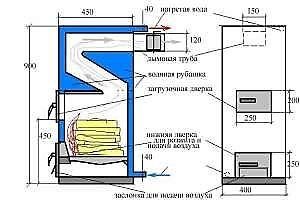
Rice. 1 Boiler with a “water jacket”
In Fig. Figure 2 shows a combined heat exchanger of the “water jacket” type (2), formed around the combustion chamber plus a slot register (3) made of steel sheet. Combustion products exit through the smoke pipe (1). Solid fuel (5) burns at the bottom of the chamber. Below it is the air supply regulator (8).
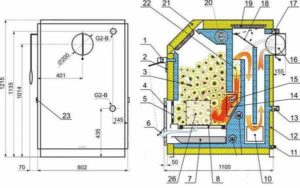
Rice. 2 Boiler with slot register
Top combustion boiler
The camera drawing is shown in Fig. 3. A cylinder-shaped boiler is made from pipes of different diameters. Air is supplied through a moving pipe that extends upward to release the firebox when fuel needs to be loaded. When burned, it begins to decrease in volume and with it the pipe also falls smoothly downwards under the weight of its weight. Uniform fuel supply is achieved using a disk welded to the base of the pipe.
The heat exchanger is designed as a “water jacket” that envelops the combustion chamber. The air is heated in the upper part of the boiler.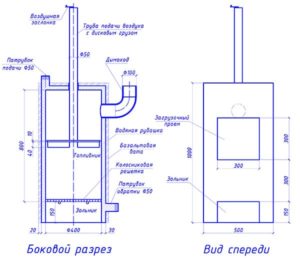
Rice. 3. Top combustion boiler
DIY solid fuel boiler
Let's look at the example of the most popular top-combustion boiler (Fig. 3). If necessary, the dimensions can be changed in proportion to those indicated in the drawing. A distinctive feature of the design is the pipe, which serves as an air supply regulator and a heat exchanger at the same time. Gases released during the smoldering process of fuel rise upward and ignite in the upper firebox.
For manufacturing, the materials described in section 2 are required: pipes, sheet steel, angle, insulation, asbestos cardboard, electrodes.
The first stage of a homemade boiler includes the following steps:
- A cylindrical body is welded from a pipe with a diameter of 45 cm and a length of 150 cm.
- The bottom is covered with a circle cut out of sheet steel using welding.
- A rectangular hole is cut out in the lower diameter pipe (lower part) for the ash pan door. It can also be made from steel sheet or purchased ready-made to size.
- The firebox is located in the upper part; a rectangle is also cut out under its door. The door must be insulated with asbestos cardboard and asbestos cord around the perimeter. All doors must be closed with latches.
- A smoke outlet pipe is welded from a profile pipe, which will be inserted into the chimney.
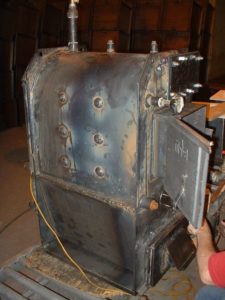
Important! Due to temperature changes, moisture (condensation) will form on the surface of the pipe, leading to corrosion, so welding seams must be of high quality.
- Legs from an equal angle angle are welded to the boiler body.
- Cut out the top cover with a diameter of 46 cm, which will fit on top of the cylindrical body.
DIY heat exchanger for a solid fuel boiler
The second stage is the production of the heat exchanger:
- A heat exchanger pipe with a diameter of 40 cm and a length of 130 cm is welded from a metal sheet.
- Insert it into a cylindrical body, fix a gap of 5 cm between the pipes, due to which a “water jacket” will form.
- The difference in the length of the heat exchanger pipes and the external one should be at least 20 cm. The pipe in the pipe is fixed by welding using prepared metal rings.
- Nozzles are installed in the upper and lower zones of the water jacket: one for supply, the other for outlet of coolant.To make them, a pipe with a diameter of 5 cm is used; a thread is screwed on the outside through which they will be connected to the pipes of the heating system.
- The distribution pipe through which air will be supplied is welded from metal of greater thickness than for the body and heat exchanger (at least 5 mm with a diameter of 6 cm). The length of the pipe is made 10 cm less than the length of the heat exchanger pipe (120 cm).
Important! The distribution pipe is located in a high-temperature zone and over time deforms and burns out, so metal with a thickness of 5 mm or more is used for its manufacture.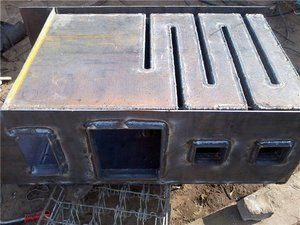
- The pipe is inserted into a prepared disk with a finished hole. A metal steel disk with a diameter of 38 cm is welded to the pipe.
- At least 4 corners are welded to the base of the disk, acting as an impeller.
- A valve is installed to the top of the pipe for portioned air supply and a loop is welded on which a chain is fixed to lift the pipe.
Attention! To improve heat transfer, a forced air fan is installed at the top of the pipe.
How to assemble a boiler correctly
After completing the two main stages, they begin the final one.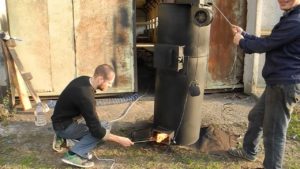
The third stage is boiler assembly:
- Select a location for installing the boiler, check the level to ensure that there are no differences that could impair the operation of the heat generator.
- The cover with the distribution pipe is pulled onto the body, having previously laid an asbestos cord. The cover can also be welded to the body.
- The smoke pipe is inserted into the chimney.
- Through threaded outlet pipes, the boiler is connected to the heating system of the house.
- The system is filled with water and the operation of the boiler is checked when it is not fully loaded.
- If the test went well, the boiler is loaded at full capacity.

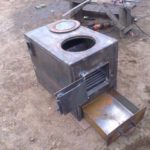
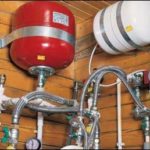

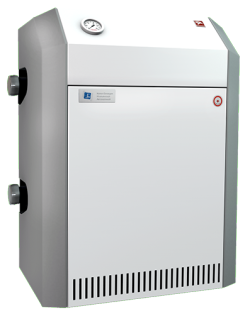

the pictures are not readable